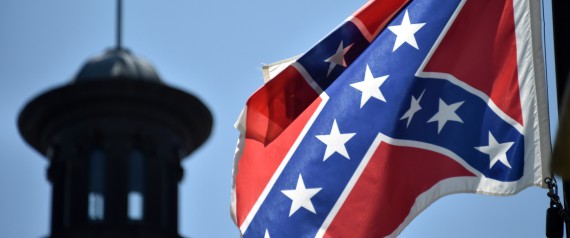
Last week’s tragic shooting at Mother Emanuel African Methodist Episcopal Church in Charleston, S.C., that killed nine black parishioners gathered for a Bible study has renewed the debate over one of the most controversial Southern symbols — the Confederate flag.
On Monday, a cascade of both Republicans and Democrats endorsed removing the Confederate flag from the statehouse in Columbia. South Carolina Republican Gov. Nikki Haley held a press conference Monday afternoon, flanked by a bipartisan coalition of lawmakers, to call for the flag to be removed. She was joined by the state’s Republican Sens. Lindsey Graham — who is running for president — and Tim Scott — the chamber’s only African-American Republican.
Here’s quick primer on how we got here:
What is the history of the Confederate flag?
Demonstrators carry Confederate flags as they leave the entrance of the South Carolina Stahouse after the removal of flag in Columbia, S.C., Saturday, July 1, 2000.
Eric Draper/Associated Press.
In December 1860, South Carolina was the first state to secede from the Union just months after Abraham Lincoln, from the anti-slavery Republican Party, was elected president. In April 1861, the first shots of the Civil War were fired at Fort Sumter, S.C.
Ten other states would eventually follow South Carolina in secession, forming the Confederate States of America. However, of the three flags the Confederacy would go on to adopt, none are the Confederate flag that is traditionally recognized today. The “Stars and Bars” flag, currently the subject of controversy, was actually the battle flag of Gen. Robert E. Lee’s Army of Northern Virginia.
After the war ended, the symbol became a source of Southern pride and heritage, as well as a remembrance of Confederate soldiers who died in battle. But as racism and segregation gripped the nation in the century following, it became a divisive and violent emblem of the Ku Klux Klan and white supremacist groups. It was also the symbol of the States’ Rights Democratic Party, or “Dixiecrats,” that formed in 1948 to oppose civil-rights platforms of the Democratic Party. Then-South Carolina Gov. Strom Thurmond was the splinter group’s nominee for president that same year; he won 39 electoral votes.
Now, the flag is a frequent emblem of modern white supremacist groups. The alleged Charleston shooter, Dylann Storm Roof, was photographed holding the Confederate flag in images on his website. Not all southerners, who believe the flag should be flown, however, see it as a racist symbol. They see it, instead, as a symbol of southern pride or as a way to remember ancestors who fought in the Civil War.
Why is it flying at the Statehouse in Columbia, S.C.?
The Confederate flag flies on the dome of the Statehouse in Columbia, S.C., in 2000.
Eric Draper/Associated Press
The flag was first flown over the State Capitol dome by Democratic Gov. Fritz Hollings in 1962 to mark the centennial of the start of the Civil War, but many saw it as a reaction to the civil-rights movement and school desegregation. For nearly four decades, it continued to be a controversial issue in the Palmetto State. A 1994 non-binding referendum placed on the GOP primary ballot found that three-in-four voters said the flag should keep flying. That same year, black ministers and the NAACP threatened a boycott of the state if the flag didn’t come down, and business leaders sued to remove the flag.
But in 2000, a compromise was reached — the battle flag would be removed from atop the dome and a smaller, square version would be placed at a less-prominent place on the Statehouse grounds — on a 20-foot pole next to the 30-foot Confederate monument. But that didn’t end the controversy, and many years of protests, criticism and boycotts followed.




